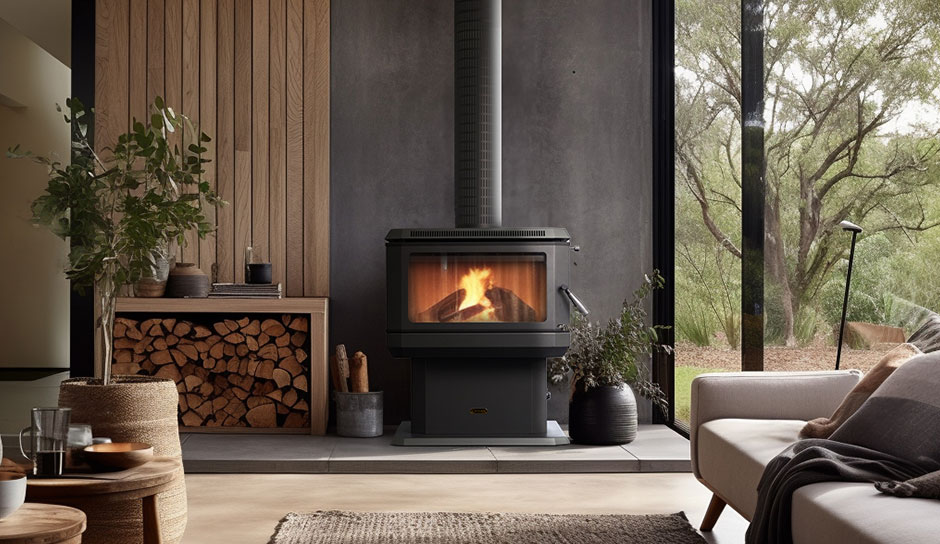Are you a busy parent or professional struggling to find time to maintain your wood heater? Look no further! Our comprehensive wood heater maintenance guide is here to help. In this article, we'll walk you through simple yet effective steps to keep your wood heater in top shape. From cleaning the flue to properly storing firewood, we've got you covered. Don't let your hectic schedule stop you from enjoying a warm and cosy home this winter. Let's get started!
Cleaning and Inspecting the Flue
One of the most important aspects about maintenance for your wood heater is the flue. It’s imperative to have the flue thoroughly cleaned and inspected annually because it is both important to allow a fire to burn correctly, and it's the most vulnerable part of the heater to buildup of creosote that may cause flue fires. The flue, much like a chimney, is susceptible to the accumulation of soot and creosote over time, which can not only obstruct airflow but also pose serious fire hazards. While it might be tempting to attempt cleaning the flue yourself, this task is best left to professional chimney sweeps who have the expertise and equipment to efficiently and safely remove any buildup. Professionals will also conduct a comprehensive inspection of the flue for any signs of cracks, damage, or other issues that might necessitate repairs. They’ll also ensure that the flue cap is secure and functioning as it should. Entrusting flue cleaning and inspection to the experts is not only a wise safety precaution but also crucial for the optimal and efficient performance of your wood heater. Regular professional maintenance will help prevent potential flue fires and guarantee a smoother operation of your heating system, providing you with peace of mind as you enjoy the warmth it offers. Your local Coonara dealer will be able to supply you with contact details of a professional flue cleaning person who will safely conduct this operation for you.
Regularly Removing Ash and Debris
To keep your wood stove running efficiently, it is important to regularly remove ash and debris. Ash and debris can accumulate in the wood burner and hinder its performance. By removing them on a regular basis, you can ensure that your wood heater operates at its best. Start by allowing the fire to burn down completely and cool off before attempting to clean the ashes. Wait at least 24 hours from the last burn before attempting this. Use a metal shovel to scoop out the ash from the firebox. Be sure to deposit the ash in a metal container and place it outside, away from flammable materials. Protect yourself from the dust from this activity by wearing a face mask. Additionally, check for any debris that may have fallen into the wood burner's door hinge or sill, such as twigs or leaves, and remove them as well. By keeping your wood heater free from ash and debris, you can enjoy its warmth and efficiency for years to come.
Checking and Replacing Gaskets and Seals
Make sure you regularly check and replace gaskets and seals on your stove to maintain its efficiency. Gaskets and seals play a crucial role in preventing air leaks and ensuring that your wood heater operates at its best. Over time, these components can become worn or damaged, leading to decreased efficiency and increased energy consumption. By inspecting the gaskets and seals periodically, you can identify any signs of wear or damage, such as cracks or gaps. If you notice any issues, it is important to replace them promptly to avoid further problems. Fortunately, replacing gaskets and seals is a relatively simple task that can be done by following the manufacturer's instructions or seeking professional assistance if needed. By taking this proactive approach, you can keep your stove running efficiently and enjoy a warm and cosy home during the colder months. Your local Coonara dealer will be able to offer the best advice on how to go about this procedure.
Properly Storing Firewood
Storing firewood correctly is essential for maintaining its quality and ensuring it burns efficiently. Wet wood smokes more and creates more creosote that can build up in your flue, creating a fire hazard. When storing firewood, it is important to keep it off the ground. This prevents moisture from seeping into the wood, which can cause it to rot and become less effective as fuel. Additionally, firewood should be stacked in a way that allows for proper airflow. This helps the wood to dry out and prevents the growth of mould or fungi. It is also important to cover the firewood to protect it from rain and dew. This will keep it dry and ready to burn when needed. By following these simple guidelines, busy families can ensure that their firewood stays in good condition and provides a warm and cosy fire during those cold winter nights.
Scheduling Professional Maintenance Checks
When scheduling professional maintenance checks, you should ensure that they are done regularly to keep your wood heater burning efficiently. Regular maintenance is crucial to ensure that your wood heater is operating at its best and to prevent any potential issues. By scheduling regular maintenance checks, you can identify and address any problems early on, before they become major issues. These checks typically involve cleaning the chimney, inspecting the flue, and checking for any signs of wear or damage. If you are unable to carry out this task yourself, it is important to hire a professional who is experienced in wood heater maintenance to ensure that the job is done correctly, especially when it comes to inspecting the flue. By staying on top of regular maintenance, you can extend the lifespan of your wood heater and enjoy efficient and safe fires all winter long.
Conclusion
In conclusion, maintaining a wood heater doesn't have to be a time-consuming task for busy families. By following the tips outlined in this guide, such as regularly cleaning the flue, removing ash and debris, checking and replacing gaskets and seals, properly storing firewood, and scheduling professional maintenance checks, families can ensure their wood heater operates efficiently and safely. With a little effort and planning, busy families can enjoy the warmth and comfort of their wood heater without added stress or hassle.
Frequently Asked Questions
How often should I clean and inspect my flue?
Your flue should be cleaned and inspected at least once a year to ensure it is free from creosote buildup and any potential blockages. This regular maintenance is crucial for the safe and efficient operation of your wood heater.
What are the signs that my gaskets and seals need to be replaced?
Signs that gaskets and seals need replacement include visible wear and tear, gaps or leaks around the door, excessive smoke or odours, and a decrease in the heater's efficiency. Regularly inspect them to ensure proper functioning.
Is it necessary to remove ash and debris from my wood heater regularly?
Yes, it is necessary to regularly remove ash and debris from your wood heater. Failure to do so can lead to reduced efficiency, increased risk of flue fires, and potential damage to the heater.
How should firewood be properly stored to prevent damage and ensure it burns efficiently?
Firewood should be stored in a dry, well-ventilated area to prevent damage and ensure efficient burning. Avoid placing it directly on the ground and stack it loosely to allow air circulation.
How often should I schedule professional maintenance checks for my wood heater?
Professional maintenance checks for wood heaters should be scheduled annually to ensure optimal performance and safety. Regular inspections by a trained technician can identify any potential issues and ensure efficient burning throughout the heating season.









